 Last winter I read Joel Salatin’s Pastured Poultry Profit. A great, very educational book about the benefits of keeping chickens in mobile coops rather than stationary coops (which I intend to get us closer towards). This book is set up for those who are looking specifically to go into the pastured poultry business, but I gleaned a lot of useful tips for us to use. After reading it and reading yet again about mass market chicken recalls, I conjured up a great plan. We would get new chicks every two years and the older chickens, who’ve made it past their egg laying prime, would become, well, soup. That would solve two problems. It would keep us well in eggs every year and we could have a safe and healthy meat harvest every two years. As with many great plans of mine, it looked great on paper and hasn’t really worked out so well in reality.
Last winter I read Joel Salatin’s Pastured Poultry Profit. A great, very educational book about the benefits of keeping chickens in mobile coops rather than stationary coops (which I intend to get us closer towards). This book is set up for those who are looking specifically to go into the pastured poultry business, but I gleaned a lot of useful tips for us to use. After reading it and reading yet again about mass market chicken recalls, I conjured up a great plan. We would get new chicks every two years and the older chickens, who’ve made it past their egg laying prime, would become, well, soup. That would solve two problems. It would keep us well in eggs every year and we could have a safe and healthy meat harvest every two years. As with many great plans of mine, it looked great on paper and hasn’t really worked out so well in reality.
After having ‘taken care of’ three sick chickens in the past few months, Scott wasn’t nearly as eager to ‘harvest’ six extra birds. ‘They still will lay pretty well their third year, won’t they?’ What can I say? We aren’t eager animal harvesters. In fact it weighs us down quite a bit to bring death to a chicken, but we do it when we have to. It’s just a reality you have to face as a chicken owner.
The birds that ideally we’d like to harvest are pretty bland on personality. We gave up long ago naming our chickens and this batch didn’t really call out to be named. This mix of Rhode Island Reds and Golden Sexlinks have always been rather stand-off-ish and have left us feeling pretty neutral about them. But, they’ve been fantastic egg layers.
So while we haven’t yet followed the first part of my plan, we did follow through on the second part. Which was to acquire new chicks. We brought home four Barred Rock chicks in November and they are really messing with my plan! These chickens have so much personality that we’ve all grown incredibly fond of them. Whenever we come outside they run towards us and follow us around like puppies. They keep us laughing with how curious they are about everything. Hopping up into trees and onto trellises. How would we ever turn these girls into soup?
Well, I’ll keep you updated you as my chicken plan progresses.
Do you have any chicken breeds that are your favorite?
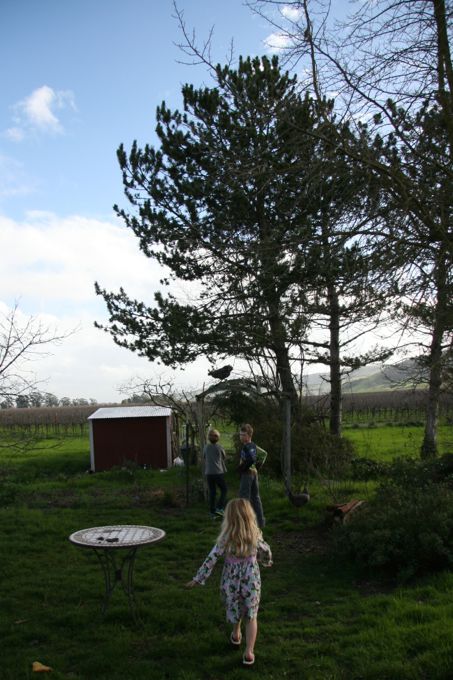
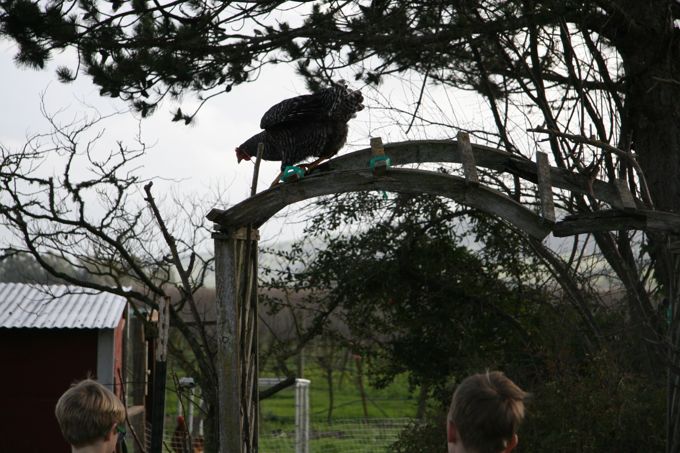
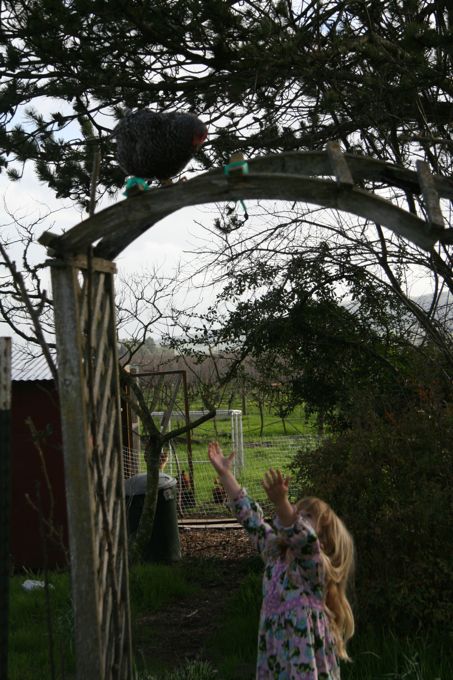
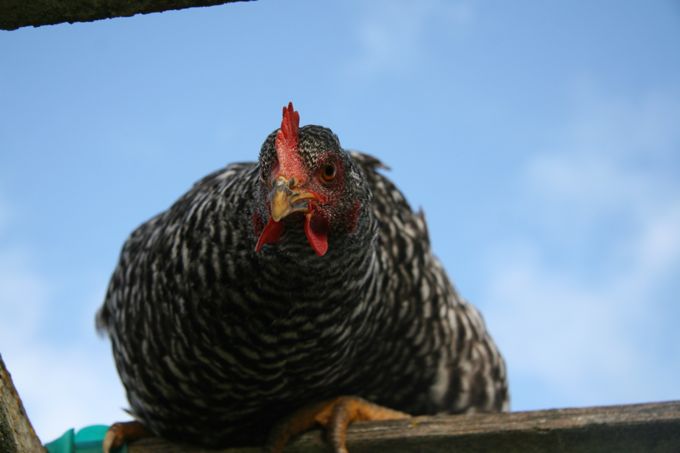
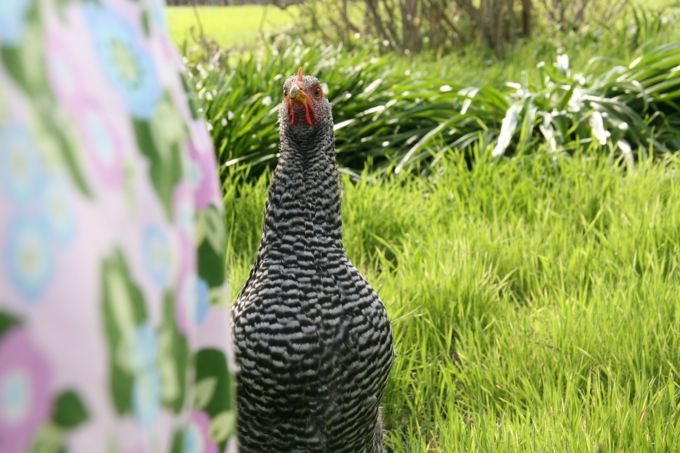
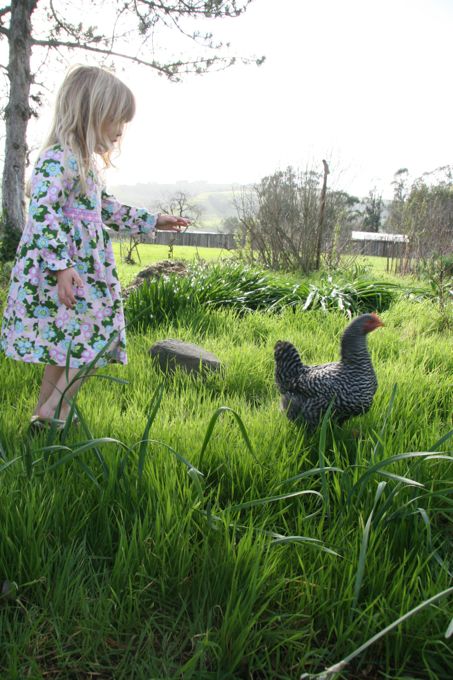
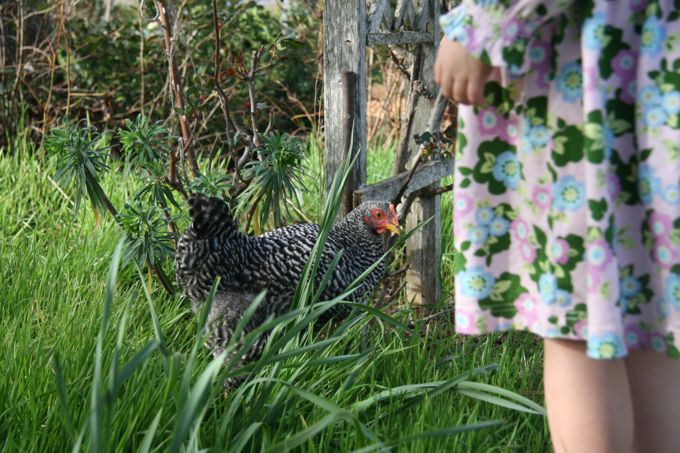



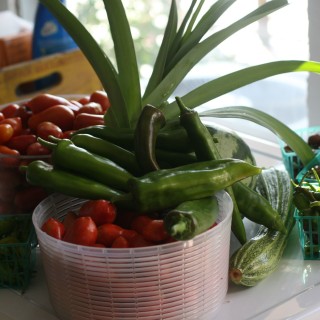





My favorite breed is the Icelandic. We are going to be keeping and breeding them this year, along with a worm bin for their (and our) pleasure. Icelandics are one of the, if not the most, thrifty birds to keep because they are mighty foragers and eat so little feed (if given the chance to range, of course). Because they are a landrace breed they are also very hardy/healthy, and come in a multitude of colors, patterns, and comb types. They are wonderful for variety in the looks department. As with any chicken individual personalities vary as well. I know many whose birds love to perch on their shoulders and come running, and just as many who say the birds are “wild”. Much has to do with how they’re raised, and then the bird itself, I think. They lay a large white-light brown (tan) egg, and can brood their own young, even in winter. They lay well throughout winter, without lights. Perhaps best of all they are amazingly hardy in both cold and hot temperature extremes. Very healthy, vigorous birds. I love them. After them, I like Silkies as pets, but admit that’s just because of how cute and sweet they tend to be, but they aren’t a very practical bird. Dorkings for meat birds, though Icelandics fulfill that just as well IMPO.
Thanks Candice for the write up about Icelandics. Truthfully I didn’t know much about them, but they sound like perfect birds to keep in mobile coops! Will think about them for the future!
No favorite breed yet, although we did have some Lavender Orpingtons that we raised from chicks, so they were very friendly. There were two hens (Henny and Penny) and a rooster (Buddy). One day Buddy came after my then 3 year old daughter, so he had to go. I wish we would have eaten him but I couldn’t bear the thought. He was an absolutely beautiful bird, but with small kids, my rule is that the roosters can stay if they are nice. We currently have two roos (a Frizzle Buff and a mix) that a friend gave us, and so far, they run away. We also have 6 Amberlinks, 2 Buffs, 1 Barred Rock, 1 Black Sex Link and 1 Silver Laced Wyandotte. None of them let us touch them, however, and they are not named. We learned that the hard way — our last group of laying hens was out foraging in the corn field next to us and they were harvested with the corn. It was a sad day! I have 18 Cochin pullet babies on their way soon from a hatchery, and from what I hear, they are the sweetest. I’m hoping that’s true!
As for ‘harvesting’ chickens, we are still not quite there yet either. It gives me a lot of pause, but I know that day is coming because I want to do meat chickens this summer. sigh. I hope I can stomach it.
We got cochins in our first round of chicks almost eight years ago AnnM. We still have one and they are indeed very sweet chickens. Oh, I can’t imagine the tragedy of having your chickens harvested with the corn! That was a sad day indeed!
I raised birds for eggs and as pets for maybe 4 years before I began raising birds for meat. You will probably find that your 2 year-old-chickens leave something to be desired when it comes to dinner. As soup they might not be bad, but I haven’t had good luck with them being tasty for much else.
If you really want to raise birds for meat, I’d recommend buying chicks for that purpose specifically. It’s easier if you know from the start what they are for. But obviously, every one has their own way!
Hi kittenofhawks. Yes after reading Pastured Poultry I really did give thought to raising specifically meat birds, however I’m not sure if we are ready for that. I thought if we could take baby steps towards culling our egg layers that would be a baby step in the right direction.
I raise birds for eggs and birds for meat. As the previous poster stated, the laying hens are not the greatest for dinner. I also found them much harder to pluck. I mean very hard. The broilers we raise are easy to pluck and are hands down the best tasting chicken we’ve ever eaten. I now take orders and process and sell birds to friends. I’m not getting rich mind you but it allows us to basically have our birds for free. Plus, I’m sharing these excellent quality chickens with others and helping them to eat healthy. The very first round of butchering was not easy emotionally but after 20 or so chickens it’s not a problem. Good luck.
Thanks for your comment Jennifer! Alright, obviously I had a crummy plan to begin with. Maybe I need to scrap my plan and wrap my head around broilers. Have you read Pastured Poultry Jennifer? It was full of helpful tips that might be useful to you.
Just to balance out the perspectives, we love eating our stewing hens and young roosters. They are very different than meat birds, but we think they are delicious and prefer them. The trick is to cook them differently too. We have the best success with roasting young roosters (6mos-1year) covered, on a lower heat (300-325) with a little liquid (water, stock, wine, cider). So much flavour! Moist white meat. If it’s an older bird and the legs are a little tougher, we just toss them in the soup pot with the bones. All the meat then becomes super-tender for amazing soup. Even our stewing hens turn out pretty well this way–braised with a little liquid.
Another key is to make sure you are aging your culled birds long enough. In other words, once they are plucked (do the dunk in hot water, makes plucking easy), keep them in the fridge for at least 24 and up to 72 hrs before freezing or cooking them.
While it’s true that the product you get is quite different than raising meat birds and stocking the freezer all at once, we really like the old-fashioned way of living with the shifting flock, eating chicken as the flock provides surplus. We have a smallish flock of 12-15 hens and a rooster, and we usually get at least a chicken/month (for 2 people). This comes from 4-6 roosters off a hatch of a dozen eggs/year plus the need to cull 4-6 stewing hens to make room for the new girls. We don’t cull all at once, either; we’ll do 2-4 at a time, which adds to the sense of the farm year. This system works well for us, so do give it a try!
Thank you backyardfeast. I appreciate your comments. Especially the tip about aging the harvested birds. Thanks!
We are constantly rotating our birds. I’ve got a hen that goes broody about once a year, and I get fertile eggs from a friend and stick those under her. Whatever she hatches that are roosters are culled as soon as they start to crow, and when the girls start to lay we cull a few of the older hens that we think have dropped in production. Its a system that works well with us, and keeps us in eggs year round. This year, when everyone else was sitting at zero laying and bald, molting hens, we were getting around 5 eggs a day.
Like what backyardfeast said, I always scald the hens, and I find plucking super easy. And the older hens are super fatty- I find them great for braising. The cocks I find hard to pluck, even after scalding, so I usually just skin them, and piece out the meat to use as skinless, boneless breasts and skinless legs & thighs. The back and neck and bits get put in a stock pot, then I shred the rest of the meat off for soups and things (which is the last step for the hens as well).
We don’t get emotionally close to most of our birds to notice different personalities, but I have a Delaware right now that HATES the cats, and its hillarious. When the cats are walking by the pen, the bird is at the wire trying to attack. Once the cat crossed their free range area and got a flying ninja arial attack. Cat was totally ok, but so hilarious. We had a leghorn in our first flock, and she was just a bag full of crazy. So much attitude for such a small bird. She was a favorite, for sure, and it would have been hard to dispatch her. Thankfully/sadly, she mysteriously died one night, saving us from having to make that decision.
We had a Barred Rock in the UK who was smart and friendly to us but rather violent to her sisters so we had to get rid of her and she joined a flock with a cockerel who kept her in order.. eventually a fox took her from our uncle’s yard. We have had loads of super friendly birds from various batches of Americanas/ Aracanas /Easter Eggers. Currently our Delaware are the most laid back.
We cull or give away our older hens but we never ever eat them… many years down the road and chewy chicken stew dinners my super frugal husband has given up on trying to eat older hens… they don’t make very good food. We do however rear our own meat birds both from Delawares in our flock which we eat a little older and meat chicks we buy off our local FFA leader when she has a surplus before fair.